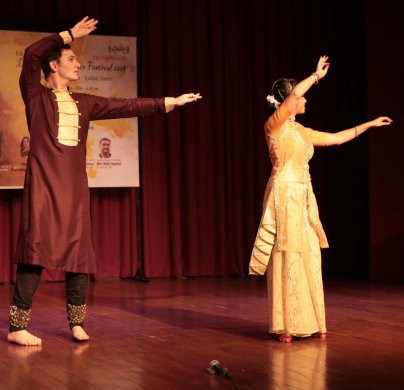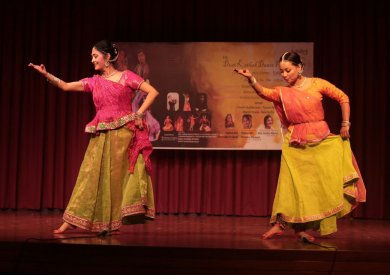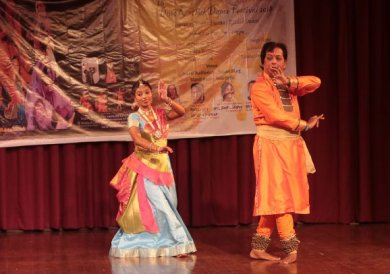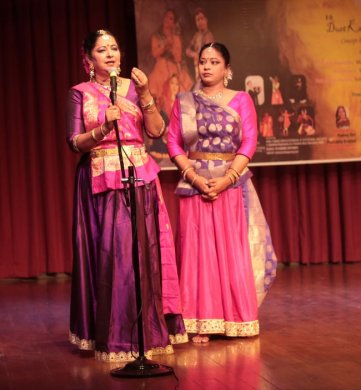
|   |

|   |
 e-mail: leelakaverivenkat@gmail.com Festival of Kathak duets December 9, 2018 Rag Virag Kala Kendra affiliated to Gandharva Mahavidyalaya Mandal Mumbai and Prayag Sangit Samiti Allahabad was initiated in 2002 by late Sheila Siddhantkar. Since 2010, Kathak dancer Punita Sharma now the General Secretary, has been organising the two-day Duet Festival of Kathak in Delhi. Supported by the Ministry of Culture, the event sponsors young talents along with more experienced artists.  Rani Khanam & Shikha Sharma When two persons share stage space in Kathak, the nritta part poses few problems. The challenge is in the traditional abhinaya segment with the Thumri, conventionally meant for solo depiction, which when presented by a pair of dancers sharing stage space calls for some imaginative designing in presentation aesthetics, with interpretative designing not marring this item's intrinsic identity. One feels that the moment a character representing the loved one being addressed in the lyric appears on stage, one has destroyed the imaginative interpretation of the song forming the very basis of abhinaya which is meant for the solo dancer through her portrayal to suggest a feel of, to the audience. And in this festival of duets, only Rani Khanam seemed to possess the right kind of creative approach in devising an interaction for two - in this case between the nayika and her sakhi (disciple Shikha Sharma) without taking away from the conventional solo feel of Chatur Nayika in the Bindadin Dadra "Thade rahiyo O more Shyam" in Bihar Adhaar. This pragalbha nayika (married but lost in her love for Shyam) as abhisarika calls out to her beloved Krishna for a tryst with the qualifying details that after adorning herself in 'solah sringar,' she will give a slip to her in-laws and set off to meet him - "saas nanad ko dekhe dilasa chali chaloongi tore dham". Rani's choreography had deft touches wherein while the sakhi is deliberately side-tracked by the nayika who deviates her attention by getting her involved in other preoccupations, she, in subtle gestural language passes on her message to the imagined loved one. Just the timing between the two, in small gestures made the entire exchange so smooth and natural that one never had the feeling of the Thumri message getting diluted because of another dancer sharing the space. With Nasir Khan on the sarangi, Suhel Athar providing vocal support and Shakeel Ahmed on tabla, Rani with her subtle abhinaya abilities succeeded admirably. The starting Devi Vandana to a Sanskrit verse featured the two dancers taking on the soft and the powerful destructive manifestations of the Devi in a complementing contrast. This was followed by the biting clarity of the nritta starting with upaj, and thaat of Lucknow gharana demonstrating its main stylistic features in movements of the griva, the kalas, the breathing and other factors of the body technique creating the total effect in this Kathak school. In a brief but telling nritta exposition choice inclusions were Anchal, Alingan, Bedam, Lamchand Paran, a convincing bandish suggesting interaction between the clouds and the nayika based on a sahityaless composition of just rhythmic syllables, Choot Ki Tihai, Paran, a composition wherein just the placing of rhythmic syllable 'dha' at vital fractional points creates the rhythmic punch and sound aesthetics. This was a recital, delicate and communicative sans showy virtuosity.  Dheerendra Tiwari & Deepti Gupta Built round the Dhamar tala, Dheerendra Tiwari, a disciple of Rajendra Gangani, in his recital proved to be a breezy performer with fine line and control in movement. The Nataraja / Natawara combine was with Deepti Gupta, from whose proficient dancing one got distracted by her disturbingly strange costume aesthetics. But the "Natawara Nateshwara Jayati Jai" alternating Nataraja and Krishna vignettes by the two dancers, was well conceived, with Yogesh Gangani's young son showing his aptitude already on the tabla.  Shikha Khare & Subima Shreshtha Shikha Khare, an experienced campaigner, with a long standing disciple of hers from Nepal, Subima Shreshtha, fully exploited the duet feature starting with permutations and combinations of rhythmic footwork built into bols 'taka digi digi…' The Badi Savari solah matra (a rarely presented 16 matra cycle by dancers today) with its accented and unaccented bols in upaj, ladi, thaat, amad, and in the drut laya, tore, tukde, parmelu, paran was followed by the Gat Nikas with the Tarana "Dheem tana dheem" ending with the Dadra, "Ranga sari gulabi chunariya re", with the sringar nayika / nayak ched chad very subtly spun round the colour of red - apart from the red 'chunariya' is the blush of the nayika due to the nayak's gaze. Refusing to talk any more, the bashful nayika says, "More mare nazariyan savariya re- jaoji jao, karona mori batiyan." Supported by Ajit Misra (tabla), Zoheb Hassan (vocal), Akram Khan (sarangi) and Vrinda providing padhant, the pair carried off the duet smoothly.  Ram Mohan & Sushmita Kanjilal Never without unexpected twists, Ram Mohan, along with his student Sushmita Kanjilal (also trained in Kalashram, Birju Maharaj's institution) began with the prayer in Hamsadhwani to Shiva- gleaming in his ash smeared grandeur with Ganga in his locks and with Parvati, his consort as the other half, "Ardhaanga." The duet enabled a Shiva/consort combine in the stances held. The vocal support though was not the best in sur singing. Making a dialogue between Krishna in "Dagar chalat dekho Shyam" and the Gopi, made the Bindadin Thumri into a rough, dance drama type of interaction, diluting the possibilities for suggestive abhinaya. But while presenting the nritta section with upaj, amad, uthan, ginti tihai, placing of dha etc, the dancer was on familiar terrain. One wishes that a long standing performer, given his presence and abilities, would stop moaning about 'being called after ten years', every time he performs, for it takes away from his dignity. Making statements on the mike faulting organisers for lack of respect for one belonging to the "khandaan" is futile, for even if lineage is venerated one cannot rest on its laurels in today's world with a plethora of performers. Why not allow the dance to speak for itself?  Neelam Choudhary & Rashmi Choudhary The Kathak presentation by Neelam Choudhary and sister/disciple Rashmi Choudhary from Bihar was disappointing with no highlights. While one does not doubt Neelam Choudhary's invaluable contribution to the advancement of dance as an administrator, (one is grateful to civilians in office who think so deeply about art advancement), performance unless pursued as a full time occupation becomes too demanding for a top bureaucrat dealing with matters of governing the State. Anukriti Vishwakarma is a well groomed Lucknow gharana disciple trained under Jaikishen Maharaj and now attached to the Bharatiya Kala Kendra. Teamed up with the upcoming talented Jaipur gharana youngster Mukesh Gangani, son of late Praveen Gangani, the couple took up Sunderlal Gangani's composition woven round the figure of sola anga and solah sringar and the iconic figure of Ram, "Paancha tatwa dhare aye Nath" in Puryadhanashree set to tritaal. Anukriti's winsome stage presence and Mukesh would form a well oiled twosome, with more practice together, with no need for verbal exchanges on stage. Right now smoothness in nritta with one following the other almost inevitably was lacking, with constant interactions. The abhinaya piece "Bhor bhie tore baat takat piya" with Radha snatching the flute from Krishna made for some light moments.  Writing on the dance scene for the last forty years, Leela Venkataraman's incisive comments on performances of all dance forms, participation in dance discussions both in India and abroad, and as a regular contributor to Hindu Friday Review, journals like Sruti and Nartanam, makes her voice respected for its balanced critiquing. She is the author of several books like Indian Classical dance: Tradition in Transition, Classical Dance in India and Indian Classical dance: The Renaissance and Beyond. Post your comments Please provide your name and email id when you use the Anonymous profile in the blog to post a comment. All appropriate comments posted with name & email id in the blog will also be featured in the site. |